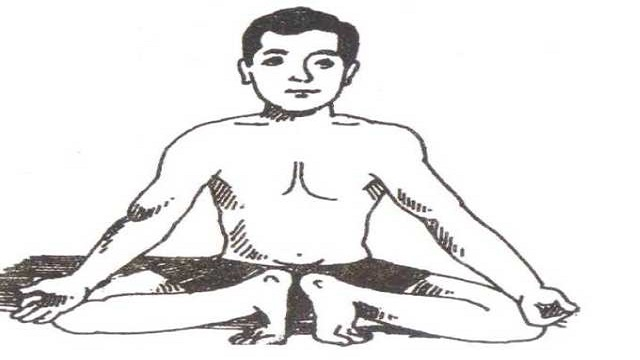Meaning of Yogasana
The word asana has many meanings such as the way of sitting, a special position of the body parts and the one on which it is seated is also called asana.
According to Sanskrit grammar, the word Asana is made of "As" ("अस") dhaatu (धातु) which has two meanings.
1. Place to sit: Like- carpet, antelope bark, bed sheet etc.
2. Body position: Like- position of body parts
Definition of Yogasana
The shape in which we make the position of our body is known by the same name. Like Kukkutasana for the position of the cocks, Mayurasana for the position of the peacock etc.. Asanas have been defined differently in different texts.
Definition of asana according to Yoga Sutra
Maharishi Patanjali, while defining asana in the Sadhana Pada of Yogasutra, has said that-
'Sthirsukhmasanam'. (Yogasutra- 2/46)
स्थिरसुखमासानम्'। (योगसूत्र- 2/46)
That is, being stable, in which there is a feeling of happiness, that is Asana.
If we analyze the above definition, then we can say that without moving the body, swaying and without any kind of anxiety in the mind, sitting comfortably in the same position for a long time is called asana.
It is clear from this definition that only meditative postures appear to come in this range, but it is not the reality. Exercise postures and relaxation postures also come under this definition because those asana also prepare the body to sit comfortably. It is through them that the body becomes healthy and gets used to sitting for a long time.
In the Tejbindu Upanishad, while defining asana, it has been said that-
“Sukhnaiva Bhavet Yasmin Jasam Brahmachintanam”
“सुखनैव भवेत यस्मिन जसम् ब्रह्मचिंतनम्”
The position in which one can sit and contemplate the Supreme Brahman continuously is called asana.
In Shrimad Bhagwad Gita, Lord Krishna says while explaining about Asanas-
Sitting on that Asanas, keeping the activities of the mind and senses under control, concentrate the mind and practice yoga for the purification of the inner self. (Shrimad Bhagavad Gita- 6/12)
The practice done by keeping the body, head and neck equal and immovable and being stable, looking at the front of your nasika and not looking at any other direction is asana. (Shrimad Bhagavad Gita- 6/13)
In the Goraksha Samhita, Maharishi Gorakshanath Ji has said about Asana-
"Asanani tutavanto pavanto jeev jantav"
"असनानि तूतवन्तो पवन्तो जीव जंतव"
That is, the posture in which all the living beings sit is known by the same name.
Swami Swatmaram ji has said about Asana in Hathapragdipika-
“Kuryattadasanam sthairyamarogyam cha laghavam”
“कू्र्यत्तदसानं स्थिर्यमारोग्यं च लाघवम्”
That is, stability (patience), health and relaxation of the body and mind are achieved through asana.
Shri Charandas ji says about Asana that-
”chauraasee laakh aasan jaano yoni kee baithak pahachaano”
“चौरासी लाख आसन जानो योनि की बैठक पहाचानो”
That is, the state in which eighty four lakh living beings sit. That asana is known by that name.
After studying various definitions, we can say that easy and pleasant state of body, mind and soul is called asana.
Objective of Yogasana
The main purpose of asanas is to get rid of physical pains and mental tensions. Asanas make the body flexible. Due to the stretching of the muscles of the body, their flexibility increases and there is an increase in activity, due to which the whole nervous system becomes healthy. After going through this process, there is harmony and uniformity in the activities of body and mind, due to which the efficiency of the seeker increases. That's why the practice of asanas is said to be necessary.
The disease-preventive form of the asanas has been presented by saying 'Asane Rujo Hanti' ('आसने रुजो हन्ति'). Asanas keep a healthy body disease-free. Its 'prevention form' becomes even more important. If the disease does not come, it is good and if the disease comes, it can also be removed.
'Asane Bhaved Drhadham' ('आसने भवेद् दृढम्') posture strengthens the body, It becomes strong and the strength increases. The organs develop equally. Therefore, posture is necessary for a healthy body.
It is important to use asanas for the protection of the health of the body and for the treatment of diseases, but the spiritual side of it is even more important.
Sadhana cannot be accomplished without the use of asanas. The position of the body chakras starts from the lower end of the spine and goes up to the Sahastrar.
Kundalini Shakti awakens and moves upward. Therefore, by keeping the spine straight, keeping the neck and head straight in the same way, there is no hindrance in the upward movement of energy and the goal can be achieved easily.
Not only this, by sitting without strengthening the body, the spine bends forward and one starts feeling sleepy. How can meditation be done in such a condition? Only a flexible spine is considered healthy. Due to which Sushamna (which is the main pulse) also remains active along with all the pulses.
Therefore, to keep Sushumna dynamic, the practice of asana is also essential. Due to the activity of Sushumna, the seeker can also do the activities of the physical world in the right way, quickly and without laziness.Therefore, it is also necessary to use the asana to achieve this purpose.


Comments
Post a Comment